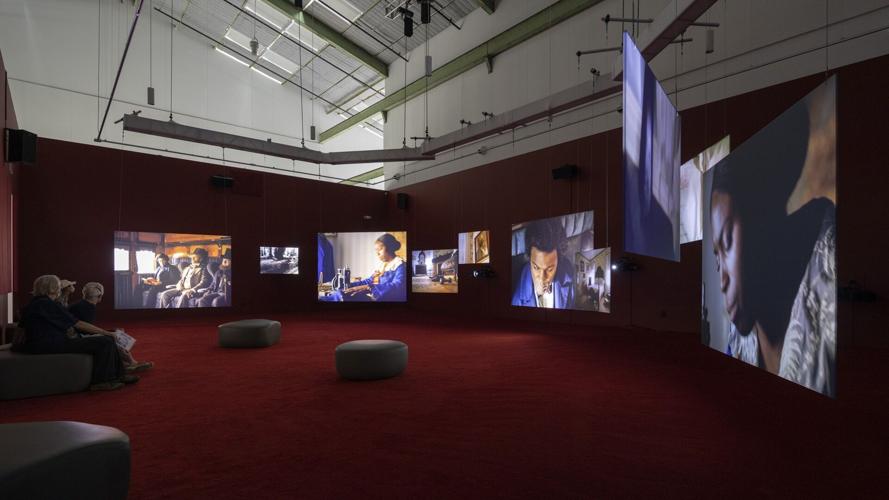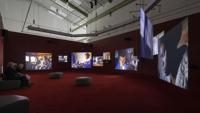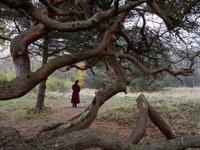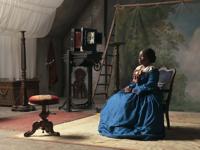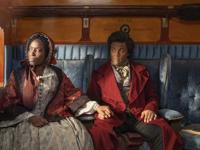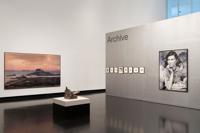Frederick Douglass understood the power of photography.
He was the most photographed man in the United States in the 1800s — yes, even more than Abraham Lincoln — and he believed that crafting a striking public image for himself could help move the abolitionist movement forward.
That power, along with Douglass’ legacy, is brought into focus through two exhibits at Skidmore College’s Tang Teaching Museum and Art Gallery.

"Rapture 1846 (Lessons of the Hour)" by Issac Julien.
The first, titled “Studio/Archive” on the ground floor, offers a feast of photography from the museum’s impressive collection, including daguerreotypes, a form of portraiture with which Douglass was well familiar.
It was one of the earliest forms of photography, invented in 1837, and it helped make portraiture more accessible to the masses. There are just over a dozen on display at the Tang and each pocket-sized portrait is set in an ornate case. None of the subjects is identified, though each piece is distinctive. Some figures look hauntingly at the viewer, while others gaze just off to the side as if talking to the artist.
The daguerreotypes are a good segue into the rest of the show, which in part focuses on how artists use photography to shape their images and capture the spirit of their communities. Alice O’Malley’s striking work, which hangs nearby, does this most directly. Called “Community of Elsewhere,” the black-and-white series spotlights artists and performers in O’Malley’s circle, particularly the Lower East Side of New York City.

"The Lady of the Lake (Lessons of the Hour)" by Issac Julien.
The poses are powerful and largely directed by the subjects themselves rather than the artist. In one, a figure sits tall on a high chair wearing only a corset, spotlighting tattoos on their arm and chest.
Elsewhere, artist Huang Yan juxtaposes the history of China with its future, putting children in front of the lens. In a triptych, a brother and sister are shown with faces painted in traditional shan shui ink brush style, with a white background ornamented with flowers and other natural imagery. It’s set against their modern school uniforms and accessories, including the soccer-ball-laden hair ties worn by the sister.

"The North Star (Lessons of the Hour)," by Issac Julien.
The “Archive” portion of the show delves into images we hold onto and questions why that might be. One standout work revisits the famous Dorothea Lange photograph “Migrant Mother,” which illustrated the hunger and desperation felt by people across the country during the Great Depression. Artist Vik Muniz, a Brazilian immigrant to the United States, offers a refreshing take on the image and recreates the portrait using thick dots of ink, the style reminiscent of comic books and newspapers. His version brings the image of the mother further into focus, blurring out the two children almost entirely.
A similar dot-matrix style is echoed in a brooding landscape nearby. Capturing the visage of Saint Malo, artist Elger Esser took a postcard of the city, photographed it and enlarged it. The piece plays with the idea of a souvenir, questioning what we can take with us.

Installation shot of "Studio/Archive" at Skidmore College's Tang Teaching Museum.
Filling another gallery wall are hundreds of identically sized photographs, grouped by theme. The artist, Joachim Schmid, collected the images from flea markets and magazines, and incorporated his photography into the series. Each grouping can be read as an archive of the theme (sunsets, German Shepherds, etc.) and a commentary on the way we frame our world.
That theme plays out across 10 screens, hung salon-style, upstairs. The film installation, titled “Lessons of the Hour,” was created by London-based artist Isaac Julien. It features Douglass, portrayed by Ray Fearon, delivering snippets of speeches on the importance of photography for furthering the abolitionist cause. Douglass is also seen with powerful women and activists of the time, including Susan B. Anthony and Ottilie Assing.

"140, Saint Malo," by Elger Esser, on view in "Studio/Archive."
The film is captivating, with vibrant, saturated colors and an aesthetic that weaves together the historical and contemporary. In some shots Douglass is in the studio, curating his image, while in others he’s speaking to crowds of people drawn to him in part because of that arresting image.
“Lessons of the Hour” will be on view through May 19. “Studio/Archive” will be up for a bit longer, running through June 9. The museum is open Tuesdays through Sundays. For hours and information, visit tang.skidmore.edu.

Installation shot of "Studio/Archive" at Skidmore College's Tang Teaching Museum.








